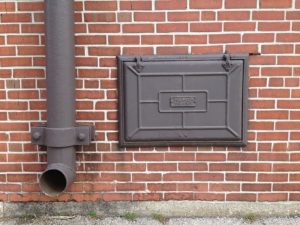 If you’ve ever explored an old home, you may have seen features not present in modern houses, some of which might even puzzle you, leaving you to wonder, “What does this thing do?” While some of these features may be of little use in this day and age, they are still fun to see, and by understanding what they were for, we can see how far we’ve come.
If you’ve ever explored an old home, you may have seen features not present in modern houses, some of which might even puzzle you, leaving you to wonder, “What does this thing do?” While some of these features may be of little use in this day and age, they are still fun to see, and by understanding what they were for, we can see how far we’ve come.
Coal Chute
In old buildings that used coal for heating, you may find a 6-to-12-inch-wide door that opens up to a passage that leads to the furnace room of the home. Coal chutes were typically constructed on the outside of the home or under the stairs. When homeowners ran out of coal, a delivery person would arrive and shovel more coal into the chute. Once the coal went through the chute into the basement, it could be shoveled directly into the furnace.
Boot Scraper
Boot scrapers can sometimes be seen in front of 18th and 19th century homes. These cast-iron contraptions were designed to give people a place to scrape dirt and debris from the bottoms of their boots before entering the home. This prevented filth from being tracked through the house. Boot scrapers can often be found driven into pieces of granite, marble, or other stone or fitted directly into walkways.
Servant Staircase
In the past, wealthier families often had either servants or slaves who would do the bulk of the cleaning, cooking, and child care in homes. These servants were often expected to stay out of sight. To accomplish this, a separate staircase was built that could easily access the kitchen and pantry.
Dumbwaiter
Dumbwaiters act as small freight elevators used to carry objects between multiple floors. Back in their heyday, dumbwaiters were commonly used to move food, laundry, or other goods from one floor to another to prevent having to carry them up and down stairs. Dumbwaiters are still used in certain places today, such as some restaurants and libraries.
Phone Niche
Long before the invention of wireless phones, telephones were not as small or sleek as they are now, but they were much more novel, leading people to create dedicated spaces for them that would both house these often-heavy devices and highlight their presence. Today, you can still find phone niches built directly into the walls of older homes. However, they are more often used now to display plants or antiques.
Push-Button Light Switch
Light switches today look much different than they did long ago. The invention of the push-button light switch came about in the 19th century. Unlike the toggle switch that most people know today, the push-button light switch consisted of small round buttons that could be used to turn the lights off and on. These buttons were notorious for getting stuck, though, which contributed to their eventual downfall. Push-button lights can be difficult to find nowadays, as they do not usually conform to modern electrical codes.
